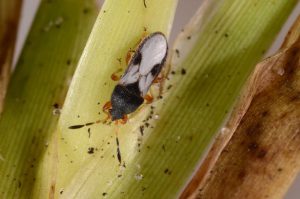Most lawn care and pest control professionals rely on insecticides to manage the southern chinch bug in Florida lawns. This is largely due to a lack of effective and easily implemented alternative integrated pest management strategies. When they rely on preventive, calendar-based, cover-spray applications of insecticides to manage chinch bugs, the risk of insecticide resistance can be high.
Insect populations become resistant to insecticides from repeated exposure to the same chemistries. Repeated exposure kills susceptible individuals and leaves resistant individuals behind to reproduce. Over time, multiple chinch bug populations have developed resistance to insecticide classes including pyrethroids, neonicotinoids, organochlorines, and organophosphates. To prevent insecticide resistance, it is highly recommended to rotate insecticides with different modes of action, or insecticide resistance action committee (IRAC) numbers. That way, multiple generations of chinch bugs within the same population are not exposed to the same insecticide class, and each population will be less likely to develop resistance. Therefore, future populations can be more effectively controlled with the tools we have.
resistant individuals behind to reproduce. Over time, multiple chinch bug populations have developed resistance to insecticide classes including pyrethroids, neonicotinoids, organochlorines, and organophosphates. To prevent insecticide resistance, it is highly recommended to rotate insecticides with different modes of action, or insecticide resistance action committee (IRAC) numbers. That way, multiple generations of chinch bugs within the same population are not exposed to the same insecticide class, and each population will be less likely to develop resistance. Therefore, future populations can be more effectively controlled with the tools we have.
Southern chinch bugs are most effectively controlled with thorough applications of systemic insecticides. Contact-toxic products may not be as effective as systemic insecticides because they depend on physical contact to work and sufficient and uniform coverage can be difficult to achieve. In contrast, systemically active products are ingested during feeding. Another benefit of most systemic products is that they pose lower risk to natural enemies, which allows biological control to occur in between insecticide applications.
Systemic products are preferable because they have longer residual activity inside plant tissue. Broad-spectrum products such as pyrethroids and carbamates may initially reduce pests, but they are not active systemically. Furthermore, they provide shorter periods of control and are less compatible with natural enemies. Several combination products that contain pyrethroids and neonicotinoids (e.g., bifenthrin + imidacloprid) may provide initial high knock-down rates followed by longer systemic control. Always follow label directions and restrictions when applying these products.
The UF/IFAS publication on Southern chinch bug management was updated in June 2018. You can view the full document here: http://edis.ifas.ufl.edu/lh036
 1
1
